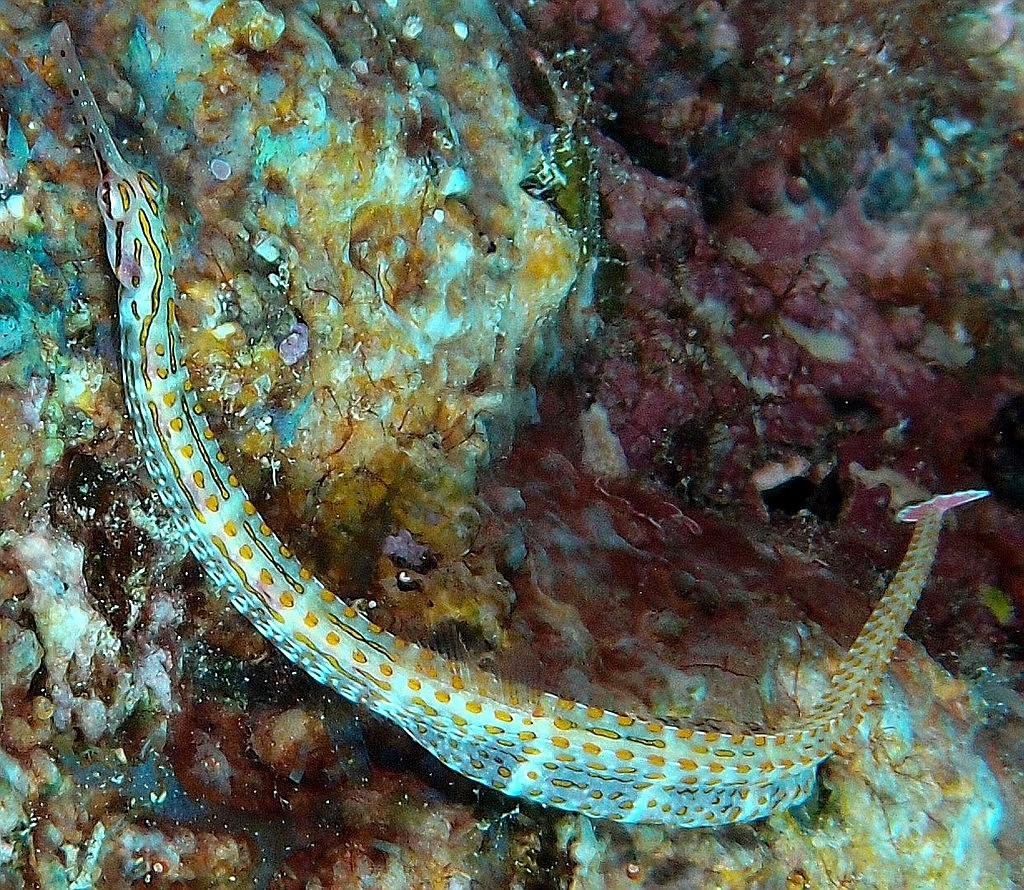CORYTHOICHTHYS OCELLATUS - (HERALD, 1953)
Actinopterygii (Gigaclass) > Actinopteri (Class) > Teleostei (Subclass) > Syngnathiformes (Order) > Syngnathoidei (Suborder) > Syngnathidae (Family) > Syngnathinae (Subfamily) > Corythoichthys (Genus)
Syngnathe à ocelles, Poisson-aiguille à points oranges, Ocellate pipefish, Ocellated pipefish, Orange-spotted pipefish,
Description
Color
Overall light greenish-yellow, body covered in small pupil-sized orange spots that are often dark ringed as ocelli, especially over the back of the trunk; Ventral surface of anterior 4-5 trunk rings heavily shaded or blotched with brown; No dark blotch ventrally on anal ring; head with diffuse dark stripe on lower third of opercle extending forward below eye; Dorsal fin without spots.
Etymology
Corythoichthys: from Greek, korys, korythos = helmet + from Greek, ichtys = fish. Referring to “elevated” head rising from large orbits (per Kaup 1856).
ocellatus: from Latin = having small eyes or an eyelike marking in the form of a spot or ring of color, as on the wing of a butterfly or the tail of a peacock. Referring to the dark-ringed ocelli on the body.
Syngnathe à ocelles, Poisson-aiguille à points oranges, Ocellate pipefish, Ocellated pipefish, Orange-spotted pipefish,
Description
Dorsal soft rays (total): 22-25; Anal soft rays: 4; Trunk rings: 15-16; Tail rings: 29-32. Head length: 5.7-7.1 in SL; Body depth: 3.5-5.4 in HL; Snout length: 1.7-2.0 in HL; Snout depth: 7.3-8.8 in snout length; Prenuchal and nuchal ridges smooth; Median snout ridge usually with slight dorsal emargination; Eye prominent. Dorsal fin origin usually at or behind the anterior margin of the first tail ring. The snout is long and slender and it has a distinct tail. Max. length: 12.0 cm TL. Depth range: 2 - 12 m.
Color
Overall light greenish-yellow, body covered in small pupil-sized orange spots that are often dark ringed as ocelli, especially over the back of the trunk; Ventral surface of anterior 4-5 trunk rings heavily shaded or blotched with brown; No dark blotch ventrally on anal ring; head with diffuse dark stripe on lower third of opercle extending forward below eye; Dorsal fin without spots.
Etymology
Corythoichthys: from Greek, korys, korythos = helmet + from Greek, ichtys = fish. Referring to “elevated” head rising from large orbits (per Kaup 1856).
ocellatus: from Latin = having small eyes or an eyelike marking in the form of a spot or ring of color, as on the wing of a butterfly or the tail of a peacock. Referring to the dark-ringed ocelli on the body.
Original description: Corythoichthys ocellatus Herald, 1953 - Type locality: Purvis Bay, Florida Island, Solomon Islands.
Distribution
Western Pacific: Indonesia, Philippines and Papua New Guinea east to Samoa, south to eastern Australia and New Caledonia.
Distribution
Western Pacific: Indonesia, Philippines and Papua New Guinea east to Samoa, south to eastern Australia and New Caledonia.
Biology
Inhabits rubble patches of shallow sheltered reefs. Individuals are either found solitary or in pairs. Sometimes collected for the aquarium trade. Alimentation unknown, likely to feed on copepods, small isopods and ostracods. Ovoviviparous (gives birth to live young). The eggs are brooded by the males in a pouch under the tail. The pouch protects the dorsal surface and side of the egg mass, leaving the ventral surface is exposed. Males begin brooding at around 58 mm SL. Eggs: Eggs deposited in 2-17 transverse rows within a gelatinous matrix. Larvae: Pelagic, morphologically similar to adults at birth.
Similar Species
Corythoichthys schultzi (Herald, 1953) - Reported from New Caledonia. Link to the species (here). Color pattern similar to that of Corythoichthys schultzi. The long snout and ocellate markings separate Corythoichthys ocellatus from all other congeners except Corythoichthys schultzi. Corythoichthys ocellatus has lower total ring and dorsal ray counts (average = 46 and 23 versus 51 and 28 in Corythoichthys schultzi) and the ventral surface of the trunk rings is more heavily pigmented. Corythoichthys schultzi also reaches a larger size (144 mm versus around 120 mm in Corythoichthys ocellatus).
Inhabits rubble patches of shallow sheltered reefs. Individuals are either found solitary or in pairs. Sometimes collected for the aquarium trade. Alimentation unknown, likely to feed on copepods, small isopods and ostracods. Ovoviviparous (gives birth to live young). The eggs are brooded by the males in a pouch under the tail. The pouch protects the dorsal surface and side of the egg mass, leaving the ventral surface is exposed. Males begin brooding at around 58 mm SL. Eggs: Eggs deposited in 2-17 transverse rows within a gelatinous matrix. Larvae: Pelagic, morphologically similar to adults at birth.
Similar Species
Corythoichthys schultzi (Herald, 1953) - Reported from New Caledonia. Link to the species (here). Color pattern similar to that of Corythoichthys schultzi. The long snout and ocellate markings separate Corythoichthys ocellatus from all other congeners except Corythoichthys schultzi. Corythoichthys ocellatus has lower total ring and dorsal ray counts (average = 46 and 23 versus 51 and 28 in Corythoichthys schultzi) and the ventral surface of the trunk rings is more heavily pigmented. Corythoichthys schultzi also reaches a larger size (144 mm versus around 120 mm in Corythoichthys ocellatus).
Last update: 27, September 2021
